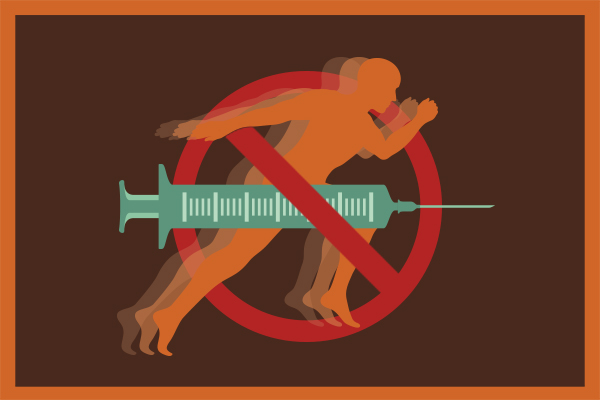Take 5: The science of doping in sports

Doping in sports continues making headlines as the U.S. Justice Department investigates state-sponsored doping by dozens of Russian athletes in the Olympic Games. The International Olympic Committee defines doping as “the deliberate or inadvertent use by an athlete of a substance or method banned by the IOC.” Those substances and methods include performance-enhancing drugs and procedures that can have a variety of effects, including increasing muscle mass, enhancing recovery, blocking pain, upping the oxygen capacity of the blood to boost muscle performance and endurance, and even preventing detection of doping itself.
We asked Northeastern’s Rui Li, associate clinical professor in the Bouvé College of Health Sciences and an expert on exercise physiology, to provide insight into how doping affects the body and what the next-generation doping and detection methods might be. “One day,” she noted, “an athlete may carry a biological passport with his or her entire inborn genome mapped out as well as a national passport.”
Doping has been widely discussed in the wake of the Olympics controversy regarding the Russian athletes. What exactly is doping?
Although the definition of doping in sports has evolved over time, doping means athletes using banned substances or methods to improve physical and/or mental performance. Doping is an artificial and illegal way of using drugs and substances in large amounts during or out of competition. Doping is not new. As early as the 8th century B.C., ancient Greek Olympians ate sheep’s testicles to enhance performance. Today we would recognize these organs as a source of testosterone, a banned substance according to the World Anti-Doping Agency, or WADA. The use of medically inappropriate substances for the treatment of illnesses and injuries solely to enable participation in competition is also regarded as doping.
The WADA 2016 Prohibited List currently includes more than 200 banned substances and methods. Which ones, or types, are most commonly used? What benefits do they provide to athletes?
Although there are numerous banned substances and methods, they can be categorized into nine classes of substances and three types of methods. One of the most commonly used class of substances is anabolic agents, including both exogenous and endogenous androgenic steroids; the former are synthetic versions of the male sex hormone testosterone and the latter are produced naturally within an organ, tissue, or cell and then extracted as products for drug use. These agents stimulate muscle growth, allowing athletes to build more muscle, train harder, and recover more quickly.
Another commonly used class of substances is stimulants, which primarily mimic the action of the hormones epinephrine and norepinephrine, making athletes more alert and fatigue resistant by increasing heart rate and blood flow.
Diuretics and masking agents are often used to hide drugs excreted in the urine or to quickly “make weight” in sports such as weight lifting and boxing. Narcotics and glucocorticoids, such as a synthetic version of cortisol, are frequently used to alleviate the pain caused by injury or fatigue.
So-called blood doping is a common method used to manipulate blood and its components. It artificially boosts the user’s red blood cell mass, enhancing the uptake, transport, or delivery of oxygen through the blood to the muscles, which can improve endurance and resistance to fatigue. This can be accomplished through transfusions or injectable hormones, such as erythropoietin, or EPO, which was developed using recombinant-DNA technology to treat anemia.
What is the physiological downside to doping? What kind of long-lasting, or even permanent, effect can it have on the body and brain?
Although doping may improve athletic performance, athletes do suffer from short-term and long-term side effects of the practice. For example, abuse of steroids disturbs the natural production of hormones in the body, which can lead to irreversible changes including male-pattern baldness, breast development in men, and masculinization in women. Long-term steroid use can also lead to kidney and liver damage. According to the National Institute on Drug Abuse, steroid abuse has been associated with cardiovascular diseases, including heart attacks and strokes, even in athletes younger than 30. Moreover, doping with stimulants and pain relievers can be addictive. These substances bind to receptors in the brain and disrupt natural signaling processes, which can cause serious mental health issues.
Gene doping, which is essentially the flip side of gene therapy, may be the next-generation doping strategy. What would it entail, and how close are we to its actually being used?
Athletes and coaches have been waiting anxiously for gene doping to become a reality since the day gene therapy became possible. Gene doping and gene therapy are based on the same principle: Both aim to modify our genetic makeup to make us healthier and stronger. Many athletes forgo EPO, described above, because it can be detected in urine samples. However, inserting genes that code for EPO into athletes would bypass detection, as the athletes themselves would be producing the hormone. Another example would be using gene therapy to turn off myostatin, a key protein that inhibits muscle growth. This technique is being clinically developed to treat muscle atrophy. Myostatin gene doping could potentially replace steroid use, producing athletes with super muscle power and strength. All of this, of course, comes with a cost: There is a threat that gene doping will eventually change the nature of sport. Battling gene doping is a huge concern for WADA, which has stated that “Gene doping represents a threat to the integrity of sport and the health of athletes.”
What scientific breakthroughs do you foresee for detecting doping?
The push-pull between the pressure for athletes to surpass human limits—which is partly driven by money—and keeping the integrity and fairness in sports is intensifying. Advances in modern detection methods include antigen detection, to track specific proteins in the blood; gene-chip analysis, to map an individual’s genome; and proteomic analysis, to identify and quantify the entire set of proteins in a cell, tissue, or organism. With these advances, I think we shall be able to establish procedures to adequately and ethically monitor and detect abuses. Indeed, one day, an athlete may carry a biological passport with his or her entire inborn genome mapped out as well as a national passport.




